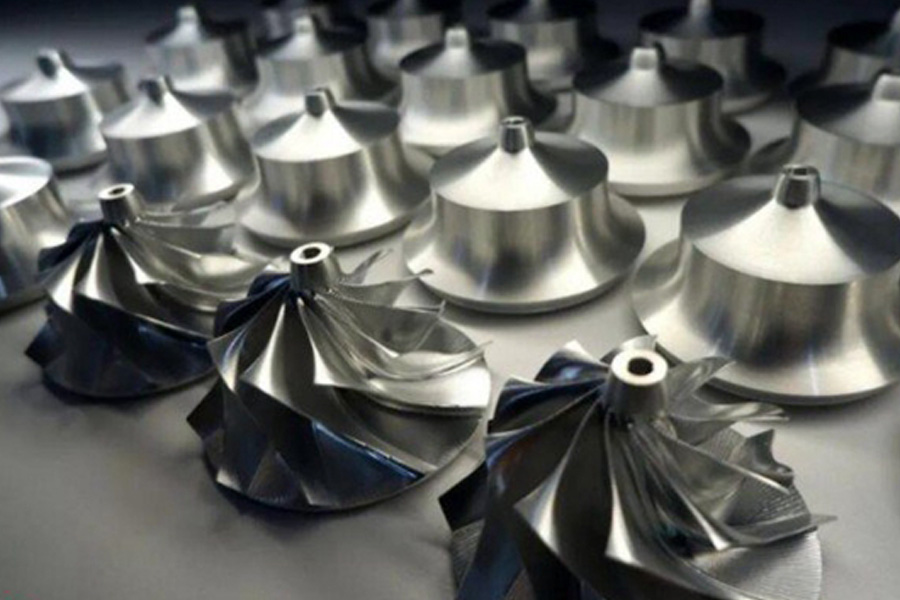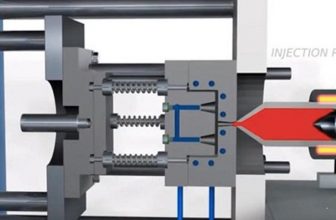
Motor sports is the vane of the development of the automobile industry. In order to win the competition, car manufacturers will use the best technology and materials in the manufacture of participating vehicles. The manufacturing technology used in racing car manufacturing is always higher than that of civilian vehicles in the same period. In the future, some of the technology used in racing car manufacturing will be applied in civil vehicle manufacturing.
The Spyros Panopoulos team, which has long been committed to the manufacturing and innovation of racing components, has developed turbochargers, impellers, pistons and other powertrain components for extreme racing sports through its patented technology and advanced materials. After years of development, on the road of technological innovation, the Panopoulos team has integrated 3D printing technology and generative design, and through these technologies, it provides technical blessings for the weight reduction and improvement of power performance of racing cars and super sports cars.
What is worth looking forward to is that in the super sports car development project carried out by the Panopoulos team, a variety of 3D printed parts are used, including carbon fiber 3D printed connecting rods, ceramic 3D printed pistons and other highly innovative parts. This sports car will be used in It will be unveiled at the 2021 Geneva Motor Show. In this issue, I will take a first look at the cutting-edge applications of 3D printing from the racing manufacturing team with netizens, and review the progress of 3D printing applications in the field of civil automobile manufacturing.
Pursue the ultimate lightweight
The racing and aircraft parts manufacturing team Spyros Panopoulos has launched a super sports car development project “Chaos”, which includes two different configurations of super sports cars. The two versions are similar in that they are equipped with a 4-liter V10 aluminum alloy engine, the engine has 20 injectors, 40 valves, titanium alloy crankshaft, titanium/inconel valve, and a large-scale made of carbon fiber and titanium alloy Twin turbocharger, the turbine of the turbocharger is made of ceramic composite material.
One configuration of the sports car is equipped with a titanium alloy 3D printed piston and connecting rod, which can accelerate to 11,000 rpm and has a power of 2,000 horsepower.
In another configuration of the sports car, the engine speed is increased to 12,000 rpm. This sports car is equipped with carbon fiber connecting rods and 3D printed ceramic composite pistons. Ceramic composite materials are known for their high strength, light weight, hardness and almost complete resistance to thermal expansion, and can be used as materials in the manufacture of space shuttles. The maximum power of the sports car is not less than 3,000 horsepower. The Spyros Panopoulos team was committed to manufacturing connecting rods, turbochargers, valves, engine blocks, flywheels and complete engines for extreme racing cars as early as 1997. The use of new materials, advanced manufacturing technologies and design methods are the driving force for them to maintain innovative vitality and break through the extreme power of vehicles in the manufacturing of racing powertrain parts. The Panopoulos team has obtained numerous innovations, patented technologies and achievements.
For example, in the application of new materials, the Panopoulos team used Tennalum alloy material for racing car manufacturing in 2015. This alloy has a yield strength of up to 700 MPa (more than 30% higher than 7075 alloy) and good ductility. And similar corrosion resistance to 7075 and other features that are beneficial to high-performance component/equipment designers. In terms of strength/weight ratio, Tennalum is 33% higher than 7075.
The Panopoulos team owns the patented technology of turbocharged impeller design and manufacture-Gen2. The impeller manufactured by this technology has 10 blades and the material is “super alloy 970 mpa”. This material is 43% lighter than titanium Ti6AL4v, but its strength is 35 higher. %. This turbocharger compressor impeller has been revolutionized in terms of aerodynamics. The radially inward part of its primary blades is swept upward into the upper area of the compressor. Thanks to the optimized geometry, its performance has been increased by 35-80%. In 2016, the team used carbon fiber compressor covers in turbochargers, and used Gen2 patented technology to manufacture carbon fiber and Lauren fiber composite turbocharger impellers, which are 8-10 times lighter than aluminum.
In recent years, Panopoulos has carried out research on next-generation materials, additive manufacturing, and generative design methods. In 2019, they made significant progress in this area.
The picture above is a 3D printed carbon fiber connecting rod, which is also a connecting rod installed in one of the sports cars of the “Chaos” project. The picture below is a racing 3D printed piston developed and designed by Panopoulos. The materials include H13 stainless steel and Ti6AL4v titanium alloy.
The Panopoulos team developed the generative design software “anadiaplasi” for the development of additive manufacturing auto parts, and designed a series of 3D printed parts through anadiaplasi, including 3D printed ceramics, titanium alloy connecting rods, pistons, and safety Sexual parts brake calipers.
The lightweight achieved by 3D printing and generative design is one of the important weights to improve the power of super sports cars. According to Panopoulos, its team’s weight reduction goal for the first mass-produced sports car is to have a total vehicle weight of less than 1,150 kilograms. Each kilogram of weight loss can generate more than 2 horsepower. They have achieved aerodynamic performance of more than 500 kilometers per hour. Be prepared. In terms of acceleration, their technology is ready to accelerate to 100 km/h in 2 seconds and 400 km/h in 7 seconds.
The above is still not the full picture of the “Chaos” super sports car. It is expected that all its technology will be seen at the Geneva Motor Show in 20201. In addition to the above 3D printed parts designed by anadiaplasi generative software, you will also see intricate LED brake light arrays, 3D printed titanium alloy exhaust pipes, carbon fiber bodywork, and an integrated chassis made of a thermosetting material. This is a material that can be used to make body armor, and its strength is 1.6 times that of aramid.
Although there are doubts about the application of 3D printing technology in the automobile manufacturing field, the challenges that restrict 3D printing to the mass production of auto parts have not yet been completely overcome. However, there are a group of companies that are brave enough to try new technologies. In the presence of uncertainty about the future, they are constantly optimizing additive manufacturing technology solutions. They are in terms of additive manufacturing design, material performance and cost, printing quality and efficiency, etc. , To promote the rapid development of 3D printing technology in the application of auto parts manufacturing. Some organizations have summarized the following five representative aspects:
l Economic feasibility in mass production
The cooperation between EDAG and Siemens has reached an important milestone. EDAG recently demonstrated a 3D printed active coolant distributor developed in cooperation with Siemens Digital Industries, and it was installed in the “EDAG SCALEbat” battery case for the first time.
With the help of Siemens CFD topology optimization software from Siemens, the coolant distributor reduces the pressure loss by 22% compared with the traditional design method. Due to the significant improvement in product performance, this coolant distributor, like the fuel injectors produced by GE, is facing the demand for industrialized production.
Integrating HP’s industrial-grade HP Jet Fusion 5200 3D printing equipment into Siemens’ digital enterprise solution can produce this coolant distributor faster, more economically, and more sustainably than before. The concept of large-scale production based on up to 300,000 pieces proves the economic feasibility of manufacturing parts through 3D printing in mass production.
l Optimize design and placement to improve printing efficiency
The BMW i8 Roadster uses powder bed metal laser melting 3D printing technology in the manufacture of the roof bracket. This technology has entered the mass production stage with the i8 Roadster.
According to BMW’s additive manufacturing partner SLM Solutions, the material of the 3D printed bracket is aluminum alloy, and the topology is optimized in the design. Its weight is 44% lighter than the original injection molded bracket, but the stiffness is increased to 10 times. BMW has also optimized the support and placement of 3D printing brackets. The number of brackets that can be printed on a substrate has increased from 51 to 238, which has significantly improved the efficiency of additive manufacturing.
l Multiple technologies to meet the production needs of different vehicles
BMW has an innovative car water pump. Similar to the standard water pump, the water wheel circulates the coolant through the engine and the rectifier to dissipate the heat generated during the combustion process. But the difference is that this water wheel adopts a monolithic design, which has the advantages of light weight and higher performance.
BMW used an integrated water wheel made by laser melting 3D printing technology in the racing car. However, the manufacturing cost of this application is higher than the demand for civilian vehicle production. BMW later adopted Desktop Metal’s production-grade binder jet 3D printing technology, which is more economical for the manufacture of civilian vehicle parts. This type of equipment can produce up to 150 water wheels at the same time, and the unit cost is about $5.
l Safety component innovation
In 2018, Bugatti released the world’s first 3D printed new eight-piston monolithic brake caliper made by selective laser melting 3D printing technology with four lasers. And recently, Bugatti conducted a breathtaking performance test on the new 3D printed eight-piston monolithic brake caliper.
So far, the main material used in the production of auto parts additive manufacturing is aluminum, while Bugatti’s new brake calipers are made of titanium. Bugatti was realized in cooperation with Laser Zentrum Nord in Hamburg, Germany. Since the beginning of 2018, the Laser Zentrum Nord has been part of the Fraunhofer Fraunhofer Institute, an expert in the field of powder bed laser melting.
It is worth mentioning that Bugatti’s use of powder bed laser melting 3D printing technology to manufacture a new eight-piston monolithic brake caliper is not just for prototypes. The performance test conducted by Bugatti further reveals the industrialization prospects of this innovation. , 3D printed titanium brake calipers will be applied to mass-produced vehicles.
l Lightweight, higher-strength new materials
EDAG, an engineering company in the German automotive field, has joined eight partners in the fields of materials, scientific research, additive manufacturing, and simulation, and is developing a lightweight, collision-resistant 3D printed aluminum alloy material with higher strength and higher fracture elongation-CustAlloy ®.
EDAG stated that CustAlloy® meets the requirements of the automotive industry in terms of strength, ductility, and corrosion resistance, and will become a 3D printing material suitable for the mass production of automotive lightweight and anti-collision parts. The additive manufacturing process developed by EDAG for this material and the practically tested simulation method are both effective tools to help users use this material for mass production of parts.
This article is reproduced from: https://3d-printing-china.com/3d-printing-carbon-fiber-ceramic-engine-parts/



